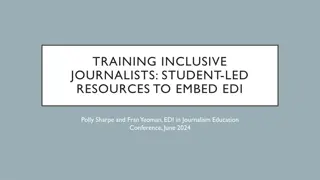Understanding the Scope and Definition of Journalism in Today's World
Journalism is described as the instant history in the making, presenting unbiased reports based on facts and evidence. It includes various channels of mass communication like audio, audio-visual, and print media. The press plays a crucial role in shaping public opinion and is considered the Fourth Estate. Journalism has evolved with the expansion of communication mediums, becoming a prestigious career choice in India.
Download Presentation

Please find below an Image/Link to download the presentation.
The content on the website is provided AS IS for your information and personal use only. It may not be sold, licensed, or shared on other websites without obtaining consent from the author. Download presentation by click this link. If you encounter any issues during the download, it is possible that the publisher has removed the file from their server.
E N D
Presentation Transcript
JOURNALISM AND MASS COMMUNICATION Mr. NOUSHAD PM. DEPARTMENT OF ENGLISH HKRH COLLEGE UTHAMAPALAYAM, THENI-625533 TAMIL NAD
JOURNALISM-DEFINITION AND SCOPE Journalism is instant history, an account of history as it is being made. (Anonymous) Journalism is a report of things as they appear at the moment of writing, not a definitive study of a situation . (Anonymous) Journalism is a contemporary report of the changing scene, intended to inform readers of what is happening around them. (Anonymous) literature in a hurry Jose A. Quirino Journalism is unbiased production and distribution of reportson current or past events based on facts and supported with proofs or evidences. The word journalism applies to the occupation, as well as citizen journalistswho gather and publish unbiased information based on facts and supported with proofs or evidences.
What is journalism? Journal is a French word derived from the Latin term diurnalis which means daily The word s first newspaper was perhaps the Acta Diurna - a handwritten bulletin put up daily in the Forum in ancient Rome.
SCOPE OF JOURNALISM Journalism covers three channels or area of mass communication Audio Audio-Visual Print
THE SCOPE OF JOURNALISM The Press is often called the Fourth Estate. The term The Press refers to printed periodicals or the newspapers, in general. Every newspaper has its own identity and wins the loyalty of is reader though a combination of words, pictures, presentation techniques, distinctive comments and exclusive news stories The newspaper is a powerful medium. It is powerful because it has the ability to influence the way people view the world, as well as their opinion of what they see.
Scope of Journalism In today s world people want to know about the current information regarding politics, sports, weather, entertainment or so on, it is possible through mass communication. The scope of mass communication increasing day by day. It is the best source to collect information from all over the world. Mass Communication considering the fourth pillar of any state. Journalism investigating and analyzing the matters and discuss it with experts. Over the years, the scope of journalism has increased as communication channels have broadened the mediums from radio, television sets, and newspapers to social media and online news websites. ... Presently in India, journalism has become a prestigious career choice for many students
Scope of Journalism May be divided into three areas 1)Written 2)oral 3) visual Periodicals such as newspapers and magazines fall under written journalism.Periodical is a publication that comes out at regular intervals daily, weekly, fortnightly, monthly, bi- monthly, quarterly, annually, etc. A newspaper, compared to a magazine, prints more news, has no special cover, and is printed on a special paper called newsprint. News is printed on the front page as wells as on the inside and back pages.
Contd A magazine prints more features and human interest stories, has a special cover usually with a big cut on it, and is often printed on bookpaper. If ever news is printed, it is brief, featurized, and found in the inside pages. Periodicals, brochures, journals, books, and graphic arts are classified under print media. Radio falls under oral journalism, while television, movies, and documentaries are under visual journalism. Radio and television are examples of broadcast media while movies and documentaries are examples of film media.
Study of Journalism Different institutes offer a bachelor in Mass communication. In that degree students learn how to report the news, writing the news and also improve their speaking skills. It is very important for a journalism student to watch the latest events happening around the world for healthy debate. Undergraduate students have the opportunity to start an internship in vacations. It helps them to increase their credibility and potential.
Journalism as Career Journalism is divided into two parts- 1) Print Media everything which is printed falls into print media. It includes Newspapers, magazines, Journals, Books, dailies, and Tabloids 2) Electronic MediaThe news which is provided through electronic devices is known as Electronic Media. It includes Radio, Television, and the Internet .A Journalist must be an all-rounder because he can collect information about Sports, Entertainment, and spiritual, Crime, Politics, and Culture and so on. They also work in newspapers and magazines. There is a lot of magazines printed in these days on education, sports, political and also for career counseling.
Career Platforms There different career platforms for a journalist: 1) Educational institute 2) Newspapers 3) Magazines 4) Advertising agencies 5) Website of publishing 6) Television channels 7) Radio Channels. A career in journalism has a lot of opportunities to work. It is a competitive field that has a huge demand in the market. There are a lot of communities of journalists in which they can share their unique ideas and give suggestions to the people about any specific issue
THANK YOU THANK YOU























